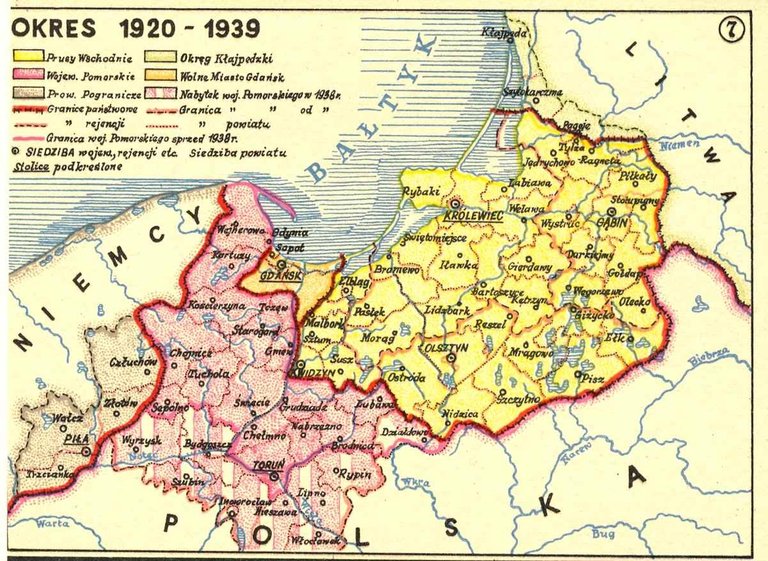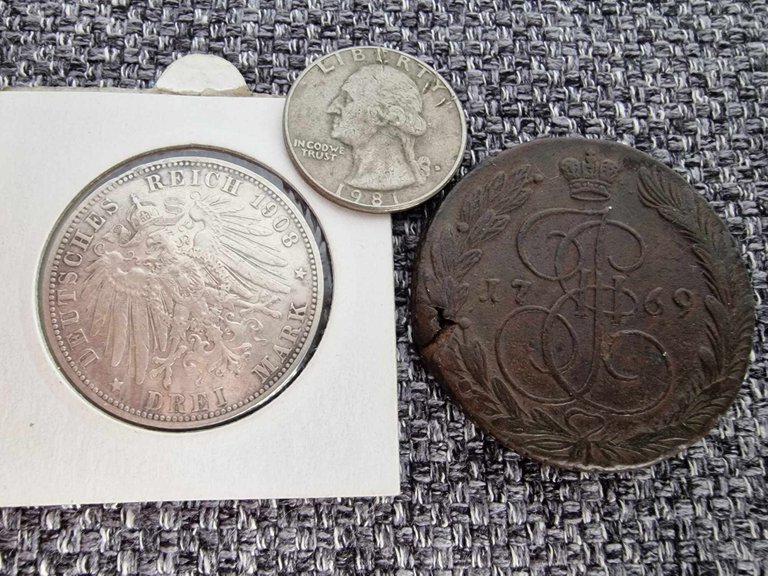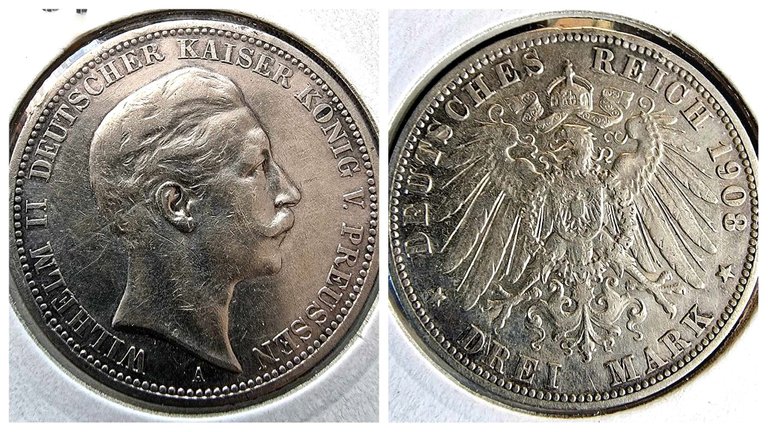Hello, I have been collecting coins for a long time, but why exactly are these German numismats? It was not a random choice, but a well thought-out one. There are several major and minor factors that influenced this option. Today, I will try to explain why I followed this path and will also talk a little about the numismatic market in Poland. You are welcome!
★ Place of residence ★

(East Prussia (1920-1939), map comes from the website "prusowie.pl")
I live near the town of Nidzica, which belonged to Germany (Prussia, Teutonic Order) for most of the time. We even have a monastic castle at our place. I mentioned earlier that I owned a metal detector and the first coin I found was a German pfennig. When deciding what I would focus my collection on, this was a very important factor. Nowadays, I don't walk around with a detector anymore because my 'wonderful government' has said that I can get up to 8 years in prison for this, which is a lot more than for beating a person.
★ Market in Poland ★
We can distinguish 3 countries whose coins are most often chosen by Poles for their collections. These are, of course, Poland, Germany and Russia. The reason for this is history. Poland was partitioned for many years and our lands became saturated with German and Russian numismatic coins. I didn't want to experiment and target coins other than these, as I would then have more trouble finding people to exchange, buy or sell. Polish coin shops also mainly stock numismats from the previously mentioned countries.
★ German coins are plentiful ★
I collect German coins up to 1945 and let me tell you, I have so much material that I can easily do this for the rest of my life. There were quite a lot of circulation coins in the German empire itself, and they were minted in many mints. To collect all the major unique circulating numismatic coins from the German Empire is a feat. One must bear in mind that it was a federal state and that Bavaria, for example, minted its own coins with Otto I on the obverse. If we add up all the Reich states and their productions, we come out with a huge collection, and we haven't even gone beyond 1871-1918.
★ German coins are relatively cheap ★
I started building my collection as a youngster, so price mattered to me. The cheapest German silver coin we can get for 15 zlotys ($3.70), it is 1/2 mark, which weighs 2.77 grams and is made of 900 silver. Larger and more interesting coins are not expensive either, compared to Polish numismats. When starting the adventure with Polish products, we have to prepare ourselves for really big expenses.
★ Summary ★
In my opinion, German coins are ideal to start collecting (at least in Europe). There is a lot of material, the price doesn't scare you off and there are just a lot of them everywhere. You can find them in any antique market or numismatic shop. Finally, I will show off another coin from my collection.

3 Mark 1908 A


Specifications:

Witam, monety zbieram od dawna, ale dlaczego akurat są to niemieckie numizmaty? Był to wybór nieprzypadkowy, a przemyślany. Jest kilka głównych oraz pomniejszych czynników, które wpłynęły na tę opcję. Dziś postaram się wytłumaczyć, dlaczego podążyłem tą ścieżką i przy okazji wypowiem się trochę o rynku numizmatycznym w Polsce. Zapraszam!
★ Miejsce zamieszkania ★

(Prusy Wschodnie (1920-1939), mapa pochodzi ze strony "prusowie.pl")
Mieszkam niedaleko miasta Nidzica, które przez większość czasu należała do Niemiec (Prus, zakonu krzyżackiego). Nawet mamy u siebie zamek zakonny. Wcześniej wspomniałem, że posiadałem wykrywacz metalu i pierwszą znalezioną przeze mnie monetą był niemiecki pfennig. Podczas podejmowania decyzji, na czym skupię swoją kolekcję, był to bardzo ważny czynnik. Obecnie nie chodzę już z wykrywaczem, gdyż mój "wspaniały rząd" stwierdził, że mogę za to dostać do 8 lat więzienia, czyli o wiele więcej, niż za pobicie człowieka.
★ Rynek w Polsce ★
Możemy wyróżnić 3 państwa, których monety są najczęściej wybierane przez Polaków do kolekcji. Jest to oczywiście Polska, Niemcy oraz Rosja. Powodem tego jest historia. Polska przez wiele lat była pod zaborami i nasze ziemie nasyciły się niemieckimi oraz rosyjskimi numizmatami. Nie chciałem eksperymentować i obrać sobie za cel innych monet niż te, gdyż miałbym wtedy większy problem ze znalezieniem ludzi do wymiany, kupna lub sprzedaży. Polskie sklepy z monetami też głównie zaopatrują się w numizmaty z wymienionych wcześniej państw.
★ Niemieckich monet jest dużo ★
Zbieram Niemieckie monety do roku 1945 i powiem wam, że mam tyle materiału, że mogę spokojnie to robić do końca życia. Samych monet obiegowych w cesarstwie niemieckim było sporo, a do tego były bite w wielu mennicach. uzbieranie wszystkich głównych unikalnych obiegowych numizmatów z czasów cesarstwa niemieckiego to wyczyn. Trzeba mieć na uwadze, że było to państwo związkowe i np. Bawaria biła sobie własne monety z Otto I na awersie. Jeśli doliczymy jeszcze wszystkie kraje rzeszy i ich produkcje, to wychodzi nam ogromna kolekcja, a nawet nie wyszliśmy poza lata 1871-1918.
★ Niemieckie monety są relatywnie tanie ★
Budowanie kolekcji rozpoczynałem jako młodziak, więc liczyła się dla mnie cena. Najtańszą niemiecką srebrną monetę możemy dorwać za 15 złotych (3,70 dolara), jest to 1/2 marki, która waży 2,77 grama i wykonana jest ze srebra 900. Większe i ciekawsze monety też nie są drogie, w porównaniu do polskich numizmatów. Rozpoczynając przygodę od polskich produktów, musimy się przygotować na naprawdę duże wydatki.
★ Podsumowanie ★
Według mnie niemieckie monety są idealne do rozpoczęcia kolekcjonowania (przynajmniej w europie). Jest dużo materiału, cena nie odstrasza i jest ich po prostu wszędzie dużo. Znajdziemy je na każdym targu ze starociami, czy sklepie numizmatycznym. Na koniec pochwalę się kolejną monetą z moich zbiorów.

3 Marki 1908 A


Specyfikacja:
